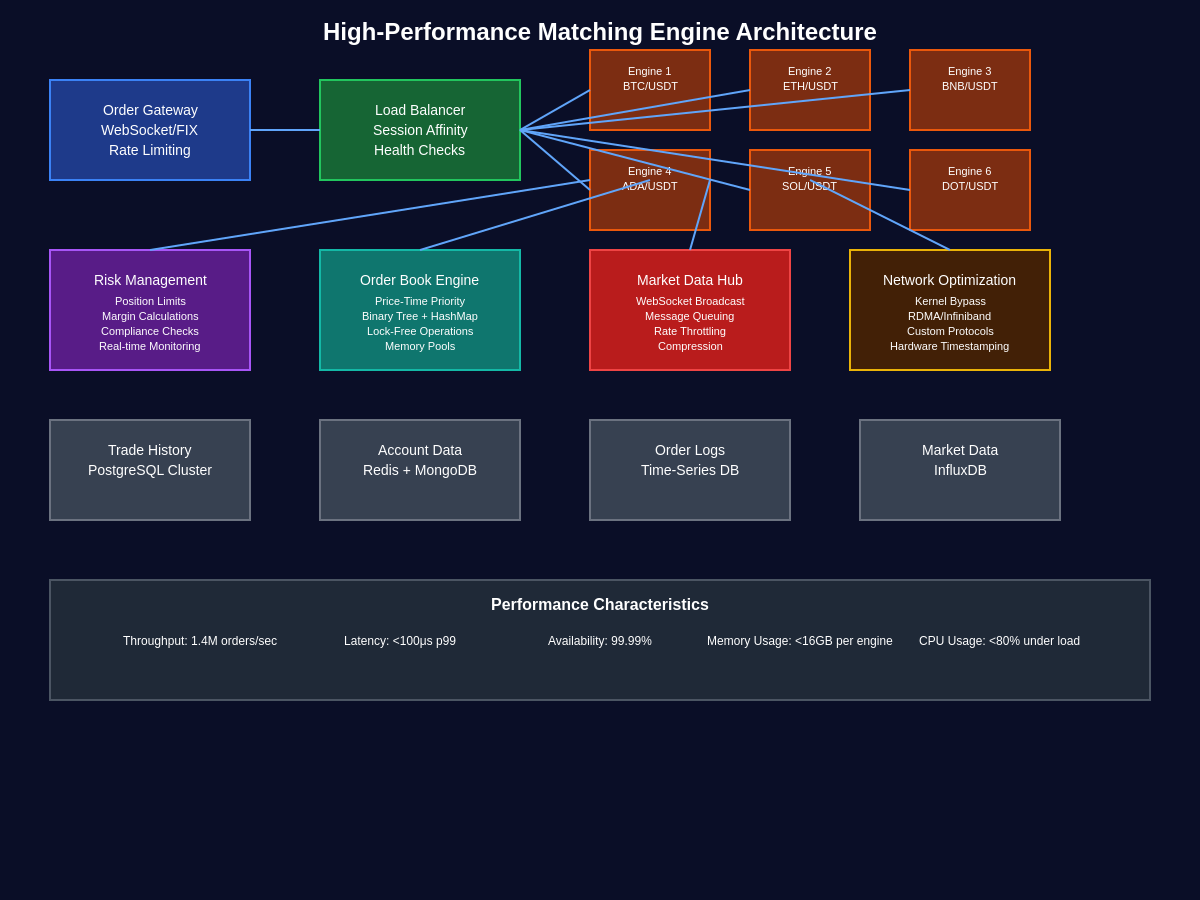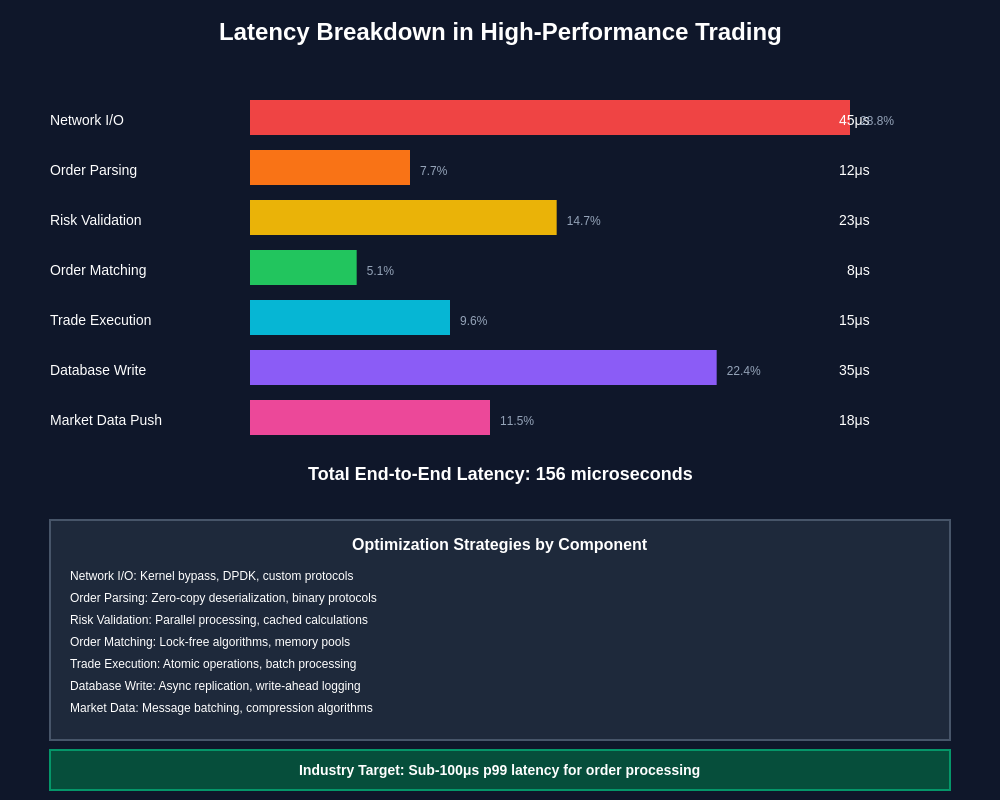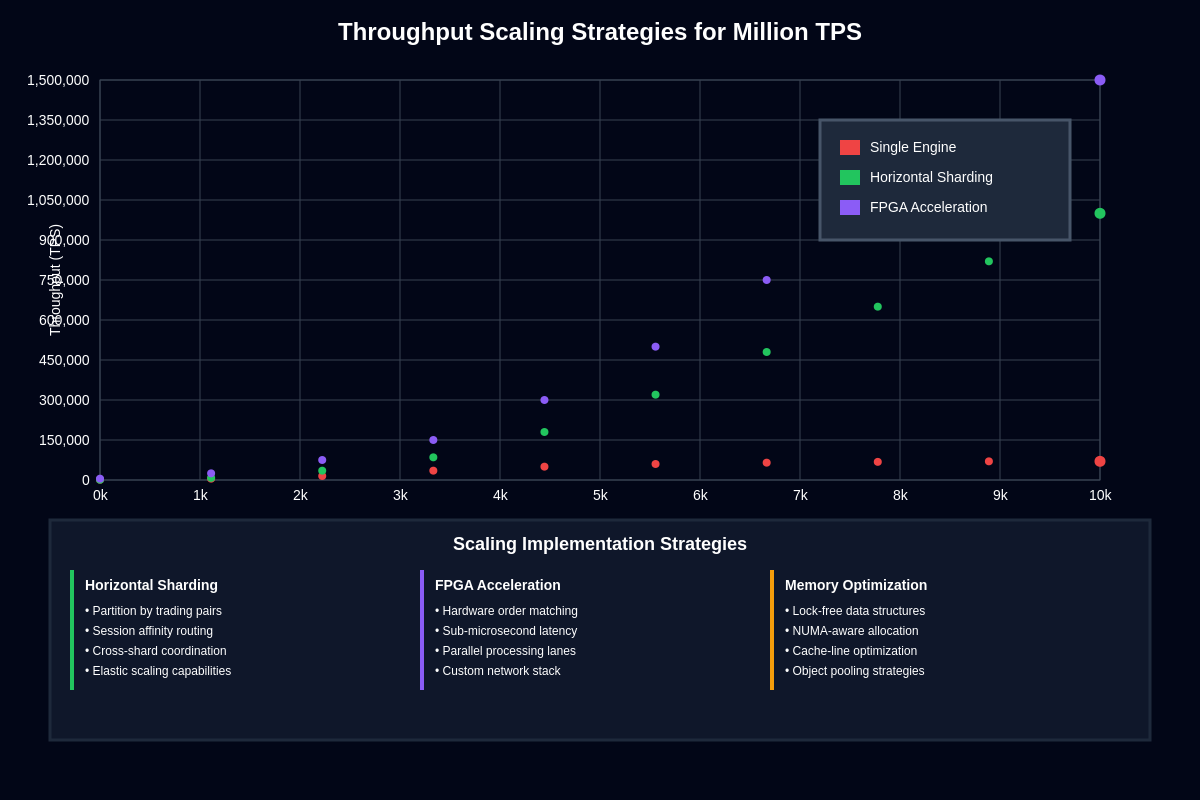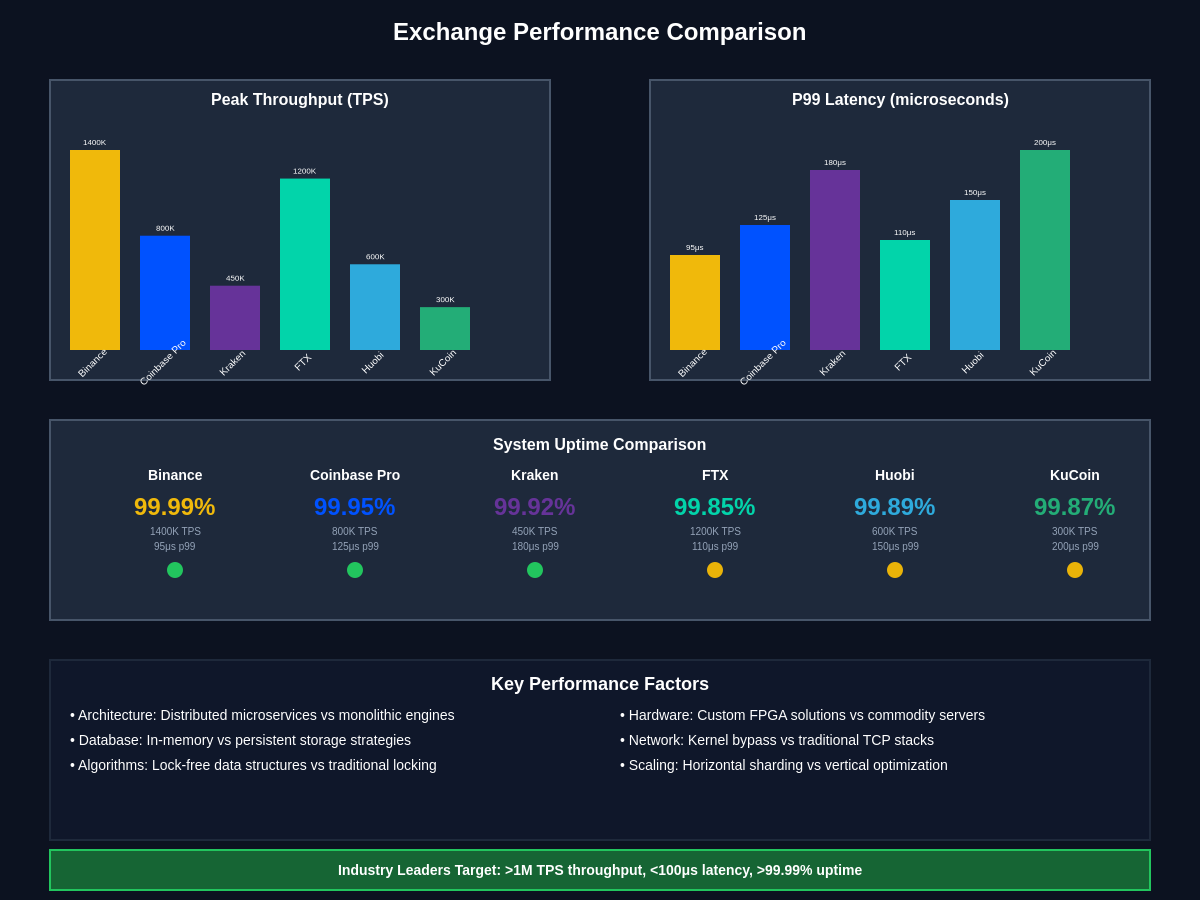The Core of Exchange Operations
The matching engine represents the beating heart of every cryptocurrency exchange, serving as the critical infrastructure component responsible for processing trading orders, maintaining orderbook state, and executing transactions at speeds that can determine the difference between profit and loss for traders operating in millisecond-sensitive markets. Modern cryptocurrency exchanges face unprecedented demands for performance as trading volumes continue to surge, with leading platforms now required to process millions of transactions per second while maintaining fairness, accuracy, and regulatory compliance. The sophisticated engineering required to achieve such performance levels involves complex distributed systems architecture, advanced data structures, optimized algorithms, and cutting-edge hardware solutions that push the boundaries of what is technologically possible in real-time financial systems.
The fundamental challenge facing exchange matching engines extends beyond raw throughput to encompass latency minimization, order fairness, system reliability, and scalability under extreme load conditions. Professional traders analyzing market movements rely on microsecond-level execution speeds that require matching engines to process orders faster than human perception while maintaining mathematical precision in order matching algorithms. The complexity of this challenge becomes apparent when considering that modern exchanges must simultaneously handle spot trading, derivatives, margin trading, and sophisticated order types while providing real-time market data feeds to thousands of concurrent users across global markets operating twenty-four hours per day without interruption.

Historical Evolution of Matching Engine Architecture
The evolution of cryptocurrency exchange matching engines reflects the broader transformation of financial technology from simple order-matching systems to sophisticated distributed computing platforms capable of handling institutional-grade trading volumes. Early cryptocurrency exchanges operated with relatively simple matching engines that could process hundreds of orders per second, sufficient for the limited trading activity that characterized the nascent cryptocurrency markets of the early 2010s but woefully inadequate for today’s demanding trading environment.
The transition from single-threaded to multi-threaded matching engines marked the first significant architectural evolution, enabling exchanges to leverage multiple CPU cores for order processing while maintaining the strict ordering requirements necessary for fair trade execution. However, multi-threading introduced complex synchronization challenges that required sophisticated locking mechanisms and careful memory management to prevent race conditions that could result in incorrect order matching or system instability.
The introduction of lock-free data structures and memory-mapped file systems represented major breakthroughs in matching engine performance, enabling systems to achieve sub-microsecond latency while handling dramatically increased throughput. These architectural innovations borrowed heavily from high-frequency trading systems developed for traditional financial markets, adapting proven techniques for the unique requirements of cryptocurrency trading including support for hundreds of trading pairs and complex order types not typically found in traditional markets.
Modern matching engines have evolved into sophisticated distributed systems that leverage techniques such as horizontal sharding, database replication, load balancing, and microservices architecture to achieve the scalability required for global cryptocurrency exchanges. The most advanced implementations utilize custom hardware solutions including FPGA-based processing units and specialized network interfaces that bypass traditional operating system overhead to achieve latency measured in nanoseconds rather than microseconds.
Core Components and Data Structures
The architectural foundation of high-performance matching engines relies on carefully optimized data structures that must balance the competing requirements of fast order insertion, efficient price-time priority matching, and rapid order book updates for real-time market data distribution. The orderbook itself typically utilizes a combination of binary trees, hash maps, and priority queues to maintain sorted price levels while enabling constant-time order insertion and deletion operations that are essential for maintaining performance under heavy load.
Price-time priority matching algorithms represent the core logic of exchange operations, ensuring that orders are matched according to established market rules that prioritize better prices first and earlier timestamps second among orders at the same price level. The implementation of these algorithms requires sophisticated timestamp management systems that can maintain microsecond-level precision across distributed systems while accounting for network latency, clock synchronization challenges, and the potential for timestamp collisions during periods of extremely high activity.
Memory management strategies play a crucial role in matching engine performance, with leading implementations utilizing techniques such as object pooling, custom memory allocators, and cache-aware data layout to minimize garbage collection overhead and maximize CPU cache efficiency. The careful management of memory allocation patterns becomes critical when processing millions of orders per second, as even brief garbage collection pauses can result in unacceptable latency spikes that affect trading performance.
Order validation and risk management components must operate at the same performance levels as the core matching logic while performing complex calculations including margin requirements, position limits, and regulatory compliance checks. These systems must access real-time account balances, position data, and risk parameters while maintaining the sub-millisecond response times required for high-frequency trading applications.
Latency Optimization Techniques
Achieving microsecond-level latency in matching engine operations requires comprehensive optimization across every layer of the technology stack, from custom kernel modifications that reduce system call overhead to specialized network hardware that bypasses traditional TCP/IP processing for critical trading messages. The most aggressive latency optimization techniques involve kernel bypass technologies that allow matching engine processes to communicate directly with network hardware, eliminating the overhead associated with operating system networking stacks that can add hundreds of microseconds to message processing times.
CPU cache optimization represents another critical area for latency reduction, with matching engine implementations carefully designed to maximize cache locality and minimize memory access patterns that could result in cache misses. Advanced implementations utilize cache-aware algorithms that arrange data structures to fit within processor cache lines, employ prefetching strategies to anticipate memory access patterns, and organize code to minimize instruction cache misses during critical execution paths.

Database and persistent storage optimization requires sophisticated techniques to maintain order durability and system recovery capabilities without compromising real-time performance requirements. Leading matching engines employ write-ahead logging systems that utilize battery-backed NVRAM or high-performance SSD storage to ensure order persistence while minimizing the latency impact of disk writes. Some implementations utilize memory-mapped files and asynchronous replication strategies that allow the matching engine to continue processing orders while persistence operations occur in parallel.
Network protocol optimization involves custom implementations of trading protocols that minimize message serialization overhead, reduce network round-trips, and utilize UDP multicast for market data distribution to reduce the computational overhead associated with maintaining thousands of concurrent connections. Advanced implementations employ custom serialization formats that are optimized for the specific data types and message patterns common in cryptocurrency trading, achieving significant performance improvements over general-purpose protocols.
Throughput Scaling Strategies
Scaling matching engine throughput to handle millions of transactions per second requires sophisticated architectural strategies that can distribute processing load across multiple systems while maintaining the strict ordering and consistency requirements necessary for fair trading operations. Horizontal scaling approaches typically involve partitioning trading pairs across multiple matching engine instances, allowing each engine to focus on a subset of markets while maintaining optimal performance for each individual market.
Database sharding strategies must carefully balance the need for distributed storage with the requirement for real-time access to account balances, position data, and order history across all trading pairs. Advanced implementations utilize consistent hashing algorithms to distribute account data across multiple database nodes while maintaining the ability to perform complex queries that span multiple shards, such as portfolio-level risk calculations that require access to positions across multiple trading pairs.
Load balancing algorithms for matching engines face unique challenges compared to traditional web applications, as trading operations require strict ordering and state consistency that cannot be achieved through simple round-robin distribution. Sophisticated implementations utilize stateful load balancing that routes orders for specific trading pairs to designated matching engine instances while providing failover capabilities that can transparently redirect traffic in the event of system failures.
Caching strategies play a crucial role in scaling read-heavy operations such as market data distribution and order book queries, with leading exchanges implementing multi-tier caching architectures that utilize in-memory data stores, CDN distribution, and edge caching to serve market data requests without impacting core matching engine performance. These caching systems must maintain real-time consistency with the authoritative order book state while serving thousands of concurrent market data subscribers across global markets.

Real-Time Market Data Distribution
The distribution of real-time market data represents a significant technical challenge that must be solved alongside matching engine optimization, as traders require immediate access to order book updates, trade executions, and price changes to make informed trading decisions. Modern exchanges must support thousands of concurrent WebSocket connections while broadcasting market data updates at frequencies that can exceed millions of messages per second during periods of high market volatility.
Message queuing systems utilized for market data distribution must balance throughput requirements with latency constraints while providing the reliability guarantees necessary for professional trading applications. Leading implementations utilize high-performance message brokers that support ordered delivery, message persistence, and subscriber prioritization to ensure that critical market data reaches high-value clients with minimal delay while maintaining fair access for all market participants.
Data compression and message batching strategies help manage the bandwidth requirements associated with high-frequency market data updates, with sophisticated implementations utilizing custom compression algorithms optimized for the repetitive data patterns common in trading messages. These systems must balance compression ratios with decompression latency to ensure that bandwidth savings do not result in increased end-to-end message delivery times.
Rate limiting and throttling mechanisms protect market data distribution systems from being overwhelmed by subscriber requests while ensuring fair access to market information across all clients. Advanced implementations utilize token bucket algorithms and dynamic throttling strategies that can automatically adjust message rates based on network conditions, client priority levels, and overall system load while maintaining compliance with regulatory requirements for fair market data distribution.
Hardware Acceleration and FPGA Implementation
Field-Programmable Gate Array (FPGA) technology represents the cutting edge of matching engine acceleration, enabling exchanges to implement critical trading logic directly in hardware to achieve latency measured in nanoseconds rather than microseconds. FPGA-based matching engines can process simple order matching operations in under 100 nanoseconds, providing significant competitive advantages for exchanges serving high-frequency trading clients who require the absolute minimum latency possible.
Custom ASIC development takes hardware acceleration even further, with some exchanges investing in purpose-built silicon designed specifically for order matching operations. These custom chips can integrate matching logic, risk management calculations, and market data distribution capabilities into a single hardware platform that operates at clock speeds impossible to achieve with general-purpose processors while consuming significantly less power than traditional server-based implementations.
Network interface acceleration involves specialized network cards that can process trading protocols directly in hardware, bypassing the operating system entirely to achieve single-digit microsecond network processing times. These solutions typically integrate with FPGA or ASIC-based matching engines to create end-to-end hardware-accelerated trading platforms that can process orders from network receipt to trade execution confirmation in under ten microseconds.
Memory subsystem optimization for hardware-accelerated implementations requires careful coordination between custom silicon and specialized memory architectures that can provide the sustained bandwidth and low latency required for high-performance order matching. Leading implementations utilize High Bandwidth Memory (HBM) and other advanced memory technologies to ensure that memory access does not become a bottleneck in otherwise highly optimized hardware platforms.
Performance Monitoring and System Observability
Comprehensive performance monitoring of matching engine operations requires sophisticated instrumentation that can capture microsecond-level timing data without introducing significant overhead to the systems being monitored. Modern exchanges implement custom monitoring solutions that utilize hardware timestamps, kernel-level instrumentation, and specialized performance counters to provide detailed insight into matching engine behavior under various load conditions.
Latency measurement strategies must account for the distributed nature of modern matching engines, with end-to-end latency measurements spanning multiple system components, network hops, and processing stages. Advanced monitoring implementations utilize distributed tracing techniques that can follow individual orders through the entire processing pipeline while maintaining the precision necessary to identify performance bottlenecks measured in microseconds.
Capacity planning for matching engine systems requires detailed understanding of performance characteristics under various market conditions, including normal trading periods, high-volatility events, and system stress scenarios. Leading exchanges utilize sophisticated modeling techniques that can predict system behavior under projected load increases while identifying potential bottlenecks before they impact trading operations.
Real-time alerting systems must operate at the same performance levels as the matching engines themselves, providing immediate notification of performance degradation or system anomalies without introducing additional latency to trading operations. These systems typically utilize custom alerting protocols that can distribute notifications across multiple channels while maintaining the reliability guarantees necessary for mission-critical trading infrastructure.
Risk Management Integration at Speed
Integrating comprehensive risk management capabilities with high-performance matching engines presents significant technical challenges, as risk calculations must be performed in real-time without impacting order processing latency while accessing complex position data, margin requirements, and regulatory limits. Modern implementations utilize parallel processing architectures that can perform risk calculations concurrently with order matching operations, providing immediate risk validation without introducing processing delays.
Position tracking systems must maintain real-time accuracy across multiple trading pairs, account types, and regulatory jurisdictions while supporting the complex position calculations required for derivatives trading, margin positions, and cross-margining strategies. These systems typically utilize in-memory databases and cache-coherent data structures that can provide microsecond-level access to position information while maintaining strict consistency guarantees across distributed system components.
Margin calculation engines face the challenge of performing complex mathematical operations involving portfolio-level risk metrics, correlation calculations, and scenario analysis while maintaining the real-time response times required for high-frequency trading applications. Advanced implementations utilize vectorized calculations, GPU acceleration, and custom mathematical libraries optimized for the specific calculation patterns common in cryptocurrency trading risk management.
Regulatory compliance systems must operate transparently within the matching engine architecture while maintaining detailed audit trails, position limits, and reporting requirements mandated by various regulatory jurisdictions. These systems must balance the need for comprehensive compliance monitoring with the performance requirements of high-speed trading operations, often utilizing asynchronous processing techniques that can maintain compliance monitoring without impacting core trading performance.
Distributed Architecture and Consensus Mechanisms
Building matching engines that can scale across multiple geographic regions while maintaining consistency and fairness requires sophisticated distributed systems architecture that can handle network partitions, system failures, and the complex coordination requirements necessary for multi-region trading operations. Leading exchanges implement consensus mechanisms that can maintain order consistency across multiple data centers while providing the fault tolerance necessary for global trading operations.
Database replication strategies for distributed matching engines must balance consistency requirements with performance constraints while supporting the complex transaction patterns associated with trading operations. Advanced implementations utilize custom replication protocols optimized for the append-only nature of trading logs while providing the strong consistency guarantees necessary for accurate order matching and settlement operations.
Conflict resolution mechanisms become critical when operating distributed matching engines, as network partitions or system failures can result in inconsistent state between different system components. Sophisticated implementations utilize vector clocks, merkle trees, and other distributed systems techniques to detect and resolve inconsistencies while maintaining the fairness guarantees necessary for regulatory compliance.
Failover and disaster recovery capabilities must operate transparently to trading clients while maintaining order book state and ensuring that no orders are lost during system transitions. Leading implementations utilize hot-standby systems, synchronized state replication, and automated failover mechanisms that can restore trading operations within seconds of detecting system failures while maintaining complete audit trails of all trading activity.
Emerging Technologies and Future Trends
Quantum computing represents a potential future disruption to matching engine technology, with quantum algorithms potentially offering exponential speedups for certain types of optimization problems common in order matching and portfolio optimization. While practical quantum computers capable of running meaningful financial applications remain years away, exchanges are beginning to research quantum-resistant security protocols and explore potential applications of quantum computing to trading optimization problems.
Machine learning integration offers opportunities to optimize matching engine performance through predictive load balancing, intelligent caching strategies, and dynamic resource allocation based on historical trading patterns. Advanced implementations are beginning to utilize reinforcement learning algorithms to optimize system parameters in real-time while neural networks analyze trading patterns to predict system load and optimize resource allocation accordingly.
Blockchain integration presents both opportunities and challenges for matching engine architecture, with some exchanges exploring hybrid models that combine high-performance centralized matching engines with blockchain-based settlement systems. These hybrid approaches aim to provide the performance benefits of centralized matching with the transparency and trustlessness benefits of blockchain technology, though significant technical challenges remain in achieving the performance levels required for high-frequency trading.
Edge computing architectures offer potential solutions for reducing latency in global trading operations by deploying matching engine components closer to major trading centers and client concentrations. These distributed architectures must balance the benefits of reduced network latency with the increased complexity of maintaining consistency across geographically distributed system components while providing the reliability guarantees necessary for financial applications.
Case Studies of Leading Exchange Implementations
Binance has achieved industry-leading performance through their custom matching engine architecture that utilizes in-memory processing, horizontal scaling across multiple trading pairs, and sophisticated caching strategies that enable processing of over 1.4 million orders per second during peak trading periods. Their implementation utilizes custom data structures optimized for cryptocurrency trading patterns while maintaining microsecond-level latency for most trading operations, demonstrating the effectiveness of purpose-built trading infrastructure over general-purpose solutions.
Coinbase Pro has focused on reliability and regulatory compliance while achieving high performance through their matching engine implementation that prioritizes order fairness and regulatory compliance alongside performance optimization. Their system utilizes sophisticated risk management integration, comprehensive audit logging, and multi-region deployment strategies that provide both high performance and the regulatory compliance necessary for operating in multiple jurisdictions while serving institutional clients with stringent reliability requirements.
FTX developed innovative matching engine features including support for complex derivatives products, cross-margining capabilities, and sophisticated order types that require advanced mathematical calculations to be performed within the matching engine itself. Their implementation demonstrates how matching engines can be extended beyond simple spot trading to support complex financial products while maintaining the performance characteristics necessary for high-frequency trading applications, though traders should monitor market developments carefully.
Kraken has implemented sophisticated security features within their matching engine architecture that provide protection against various attack vectors while maintaining high performance trading operations. Their system demonstrates how security considerations can be integrated into high-performance trading systems without compromising throughput or latency requirements, utilizing techniques such as order validation, rate limiting, and anomaly detection that operate transparently within the matching engine processing pipeline.

Performance Benchmarking and Industry Standards
Establishing meaningful performance benchmarks for matching engine systems requires careful consideration of the various factors that affect trading performance, including order types, market conditions, system load, and client distribution patterns. Industry-standard benchmarks typically measure peak throughput under idealized conditions, average latency under normal load, and system behavior during stress scenarios that simulate extreme market volatility or system failures.
Latency measurement methodologies must account for the complex processing pipeline involved in modern matching engines, with measurements typically including network receive time, order validation processing, matching algorithm execution, trade execution confirmation, and market data distribution latency. Standardized measurement protocols help ensure consistent comparison between different exchange implementations while accounting for the various factors that can affect measured performance.
Throughput testing strategies involve generating synthetic trading loads that simulate realistic market conditions while measuring system performance under various scenarios including normal trading periods, high-volatility events, and system stress conditions. These tests must carefully balance realism with reproducibility to provide meaningful performance comparisons while avoiding the complexity of real market conditions that can make benchmark results difficult to interpret.
Reliability metrics complement raw performance measurements by evaluating system availability, fault tolerance, and recovery capabilities under various failure scenarios. Leading exchanges typically achieve availability measurements exceeding 99.99% while maintaining performance guarantees during planned maintenance, system upgrades, and unexpected failures that could affect trading operations.
Regulatory Compliance and Performance Trade-offs
Regulatory requirements significantly impact matching engine architecture and performance, with various jurisdictions mandating specific order handling procedures, audit logging requirements, and market surveillance capabilities that must be integrated into high-performance trading systems without compromising speed or reliability. These requirements often involve trade-offs between optimal performance and regulatory compliance that require careful architectural decisions.
Order handling regulations require matching engines to implement specific fairness guarantees, timestamp accuracy requirements, and order priority rules that may not align with optimal performance strategies. Compliance with these regulations often requires additional processing overhead, more complex data structures, and enhanced logging capabilities that can impact system performance while providing the regulatory guarantees necessary for legal operation.
Market surveillance integration requires matching engines to provide real-time access to trading data for regulatory monitoring systems while maintaining the privacy and security guarantees necessary to protect proprietary trading strategies. These requirements typically involve complex data sharing protocols, access control mechanisms, and audit logging capabilities that must operate transparently within the matching engine architecture.
Reporting and audit requirements mandate comprehensive logging of all trading activities, system performance metrics, and operational events that must be maintained for extended periods while remaining accessible for regulatory inquiries. These requirements often involve significant storage and processing overhead that must be carefully managed to avoid impacting real-time trading performance while maintaining the data integrity necessary for regulatory compliance.
Economic Impact and Business Implications
The performance characteristics of matching engines directly impact exchange business models through their effect on trading volume, client satisfaction, and competitive positioning within the rapidly evolving cryptocurrency trading landscape. Exchanges with superior matching engine performance typically attract higher trading volumes, more sophisticated clients, and premium pricing for their trading services, demonstrating the direct business value of technical performance optimization.
Market maker relationships depend heavily on matching engine performance, as professional market makers require predictable latency, fair order handling, and reliable execution guarantees to operate profitably while providing liquidity to retail traders. Exchanges that can provide superior performance characteristics typically negotiate better terms with market makers while attracting more competitive spreads that benefit all market participants through improved pricing and liquidity.
Institutional adoption of cryptocurrency trading depends significantly on exchange infrastructure reliability and performance, with institutional clients requiring the same level of technical sophistication and operational reliability they expect from traditional financial markets. Institutional traders analyzing market structure demand matching engine performance that can support large order sizes, complex trading strategies, and the risk management requirements necessary for professional trading operations.
Technology investment costs for matching engine development and optimization represent significant ongoing expenses for exchange operators, with leading implementations requiring specialized hardware, custom software development, and highly skilled engineering talent that can command premium compensation in competitive technology markets. These costs must be balanced against the revenue benefits of improved performance while considering the ongoing maintenance and upgrade requirements necessary to maintain competitive positioning.
Disclaimer: This article is for educational and informational purposes only and should not be construed as financial advice. Cryptocurrency trading involves substantial risk of loss and is not suitable for all investors. The performance characteristics and technical details described may vary significantly between different exchange implementations and market conditions. Readers should conduct their own research and consult with qualified financial advisors before making any investment decisions. The author and publisher are not responsible for any financial losses that may result from trading activities or reliance on information contained in this article.